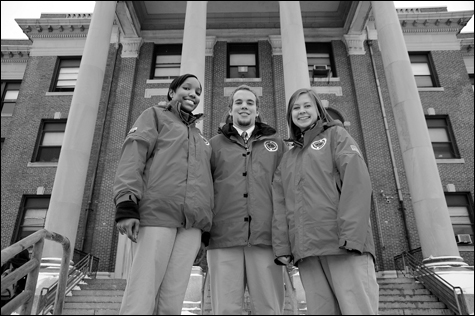
ON A MISSION Co-team leaders Jess Evora (left) and Pecho (right) with Ethan Risom. |
The highly publicized turmoil at Central Falls High School is but the leading edge of a major crisis in urban education in this state.
The "achievement gap" separating white and Latino students in Rhode Island is jaw-dropping. And if you're a poor kid who lives in the wrong zip code, graduating high school is a 50/50 proposition — with profound implications for the state's long-term economic health.
The responsibility for fixing the problem will fall, by and large, to teachers, principals, and administrators. It always does. But the schools, it is plain, could use some help from the outside. Some shock troops.
Hell, they could use an urban peace corps.
The state, per chance, has one: City Year Rhode Island — local wing of a sprawling non-profit that puts youthful, low-wage workers in urban schools, outfitted with bright red jackets, tan boots, and increasingly sophisticated training.
And the group, long considered a lightweight in social service circles, is quietly building an ambitious assault on the dropout crisis: an intense, data-driven effort to identify the at-risk before it's too late, to steer hundreds of mostly poor, mostly brown kids away from a life of crippling disadvantage.
But the effort, however promising, is nascent. Unproven. And it has required City Year to engage in a wholesale transformation that raises unsettling questions about democracy, diversity, and the nature of social change.
ORIGINS
Michael Brown, co-founder and CEO of City Year, sits in a bright, attractive office on the fifth floor of the organization's gleaming national headquarters in Boston's Back Bay.
The $17 million building has been home for almost four years now. But Brown still seems a little tickled by the finer features.
He started City Year with his Harvard Law School roommate Alan Khazei in 1988. And for years, the group did the non-profit shuffle — moving from rented space to rented space, huddled around a long line of donated, peeling tables.
The headquarters doesn't really qualify as an arrival, though. It's more like a coronation: City Year has long had an outsize role in the national service movement, which aims to funnel the energy and idealism of thousands of young people and senior citizens into good works each year.
The corps was formed in a bid to show that national service, then just an idea, could work. And it quickly emerged as a rock star in non-profit circles.
Corporate sponsors from Timberland to Cisco offered up millions. President Clinton put it at the center of his signature AmeriCorps program, which now funds almost one-third of City Year's budget.
And for years, the late Massachusetts Senator Edward Kennedy took care to don his City Year coat, "Ted" stitched on the chest, before dashing across Nantucket Sound in his 50-foot schooner Mya — photo-ops for a group on the make.
City Year started in Boston. Providence was the first expansion site. Eighteen other American cities followed. And City Year even went global, adding corps in London and Johannesburg, South Africa.
The focus, in the early years, was inward. The organization aimed, above all else, to turn its corps members into civic leaders. And central to that effort was an extraordinary commitment to diversity.